Analysis of Financial Performance and Position: Travel Companies
VerifiedAdded on 2023/03/21
|15
|4886
|23
Report
AI Summary
This report presents a financial analysis of three major travel companies: Thomas Cook, TUI Group, and Carnival Plc. The analysis focuses on the application of ratio analysis as a performance measurement tool, drawing on academic and sector literature to support the evaluation. The report examines profitability, liquidity, and other relevant financial ratios to assess the companies' financial positions. The study includes a critical examination of the advantages and disadvantages of using financial ratios, supported by academic viewpoints. Based on the findings, the report offers recommendations for improving future business performance. The report also explores the companies' strategies for achieving financial success, including innovation and customer-centric approaches. The analysis covers financial data from 2017 and highlights key factors influencing the companies' financial outcomes, such as market conditions and strategic decisions. The report aims to provide insights into the financial health and performance of these travel industry leaders.
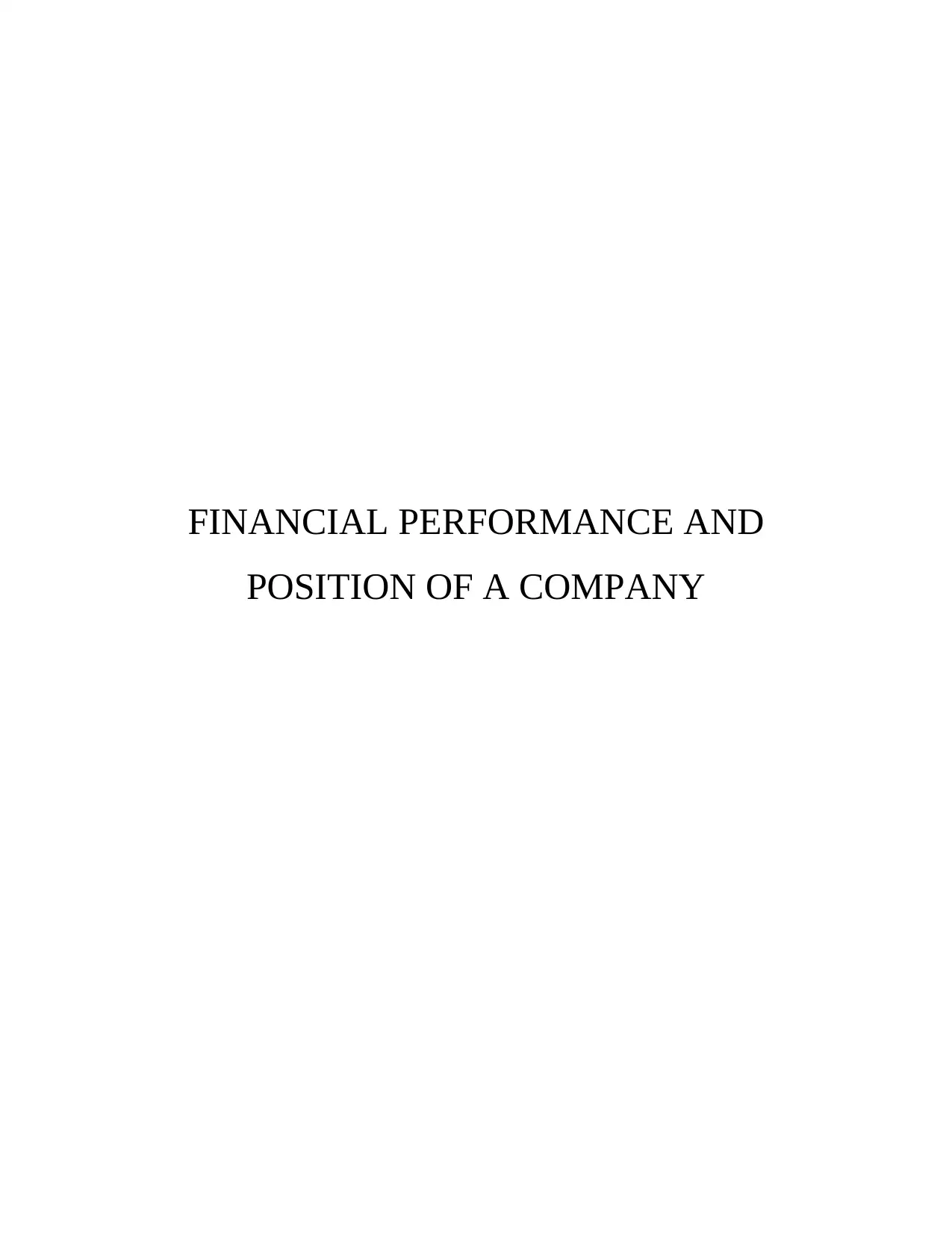
FINANCIAL PERFORMANCE AND
POSITION OF A COMPANY
POSITION OF A COMPANY
Paraphrase This Document
Need a fresh take? Get an instant paraphrase of this document with our AI Paraphraser
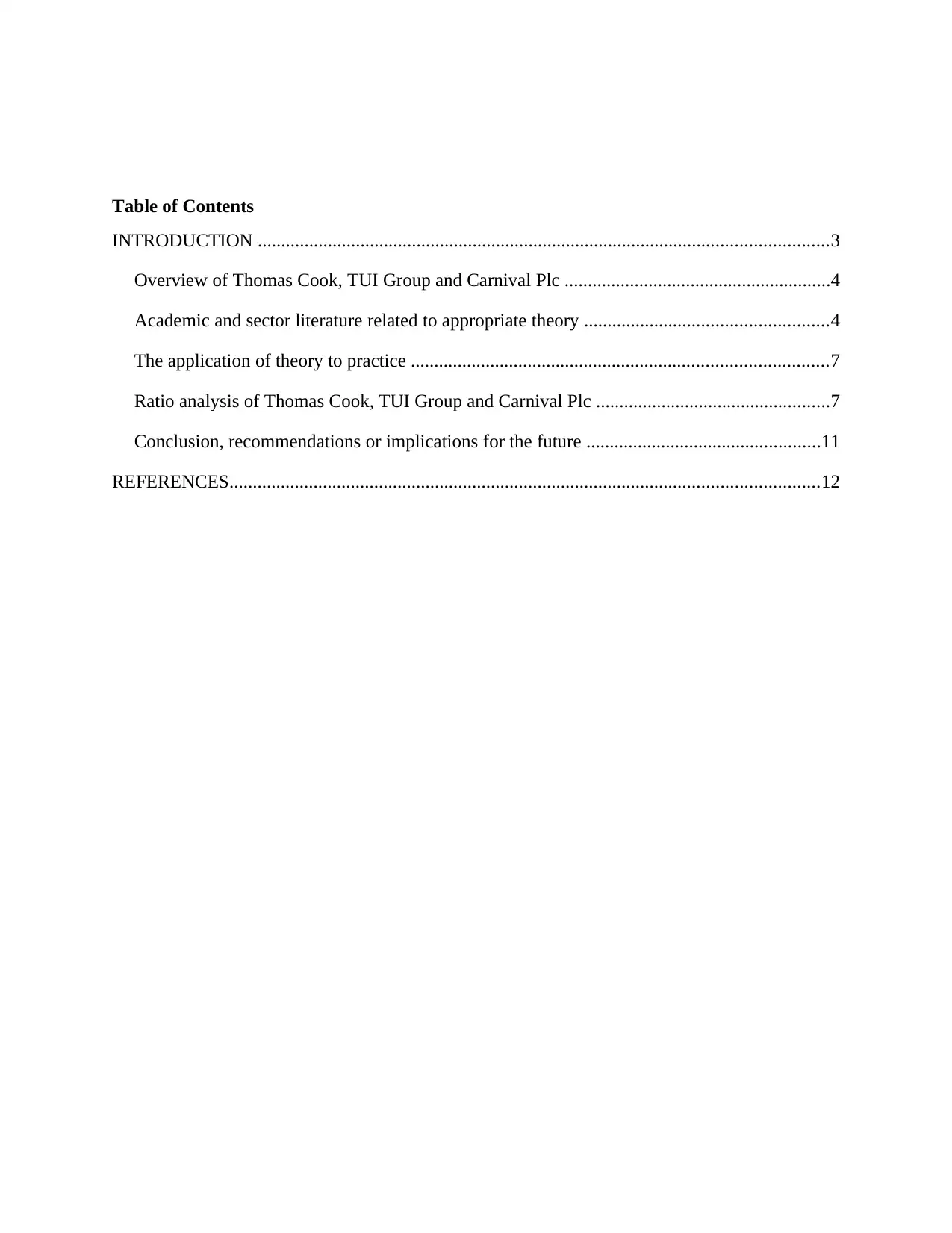
Table of Contents
INTRODUCTION ..........................................................................................................................3
Overview of Thomas Cook, TUI Group and Carnival Plc .........................................................4
Academic and sector literature related to appropriate theory ....................................................4
The application of theory to practice .........................................................................................7
Ratio analysis of Thomas Cook, TUI Group and Carnival Plc ..................................................7
Conclusion, recommendations or implications for the future ..................................................11
REFERENCES..............................................................................................................................12
INTRODUCTION ..........................................................................................................................3
Overview of Thomas Cook, TUI Group and Carnival Plc .........................................................4
Academic and sector literature related to appropriate theory ....................................................4
The application of theory to practice .........................................................................................7
Ratio analysis of Thomas Cook, TUI Group and Carnival Plc ..................................................7
Conclusion, recommendations or implications for the future ..................................................11
REFERENCES..............................................................................................................................12
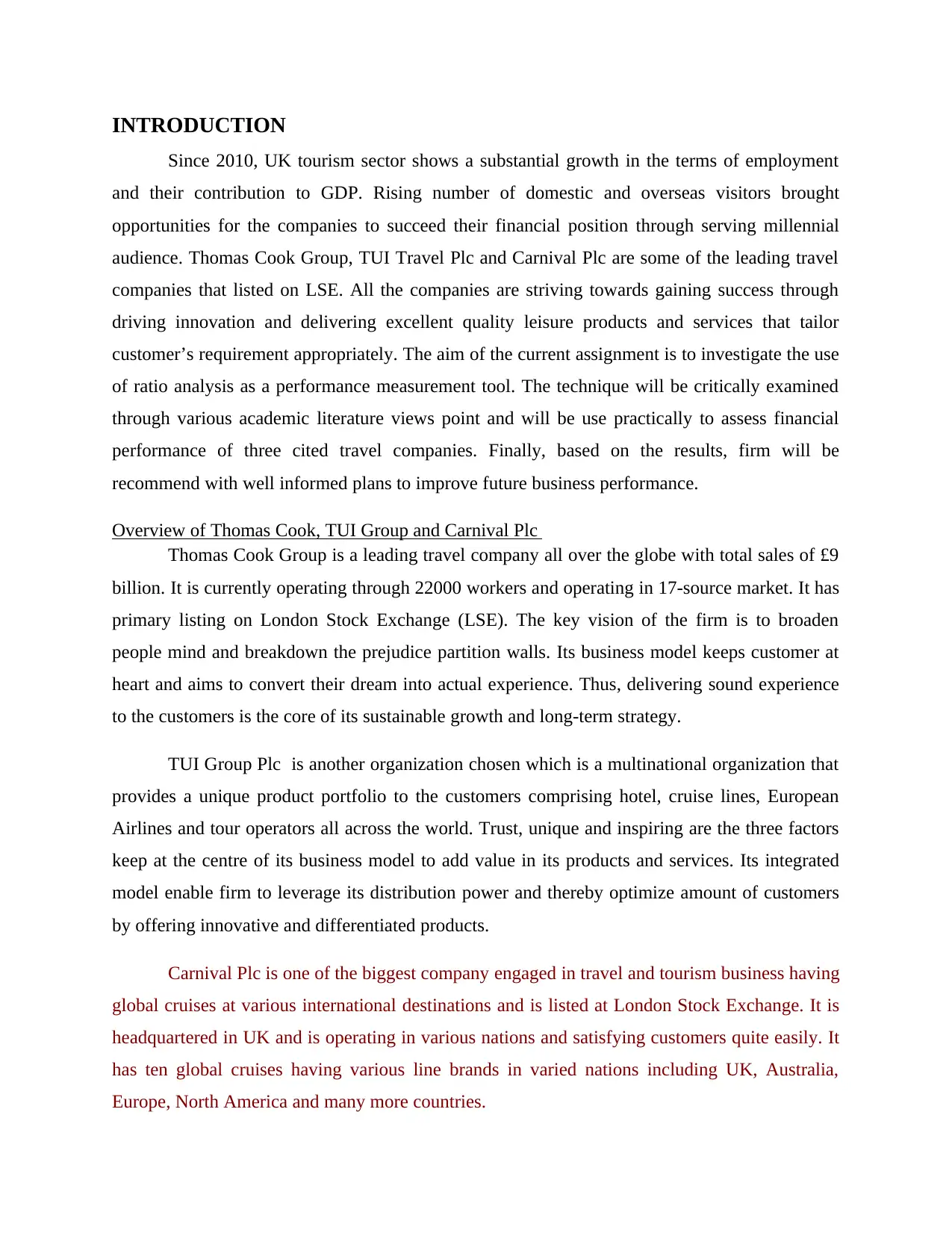
INTRODUCTION
Since 2010, UK tourism sector shows a substantial growth in the terms of employment
and their contribution to GDP. Rising number of domestic and overseas visitors brought
opportunities for the companies to succeed their financial position through serving millennial
audience. Thomas Cook Group, TUI Travel Plc and Carnival Plc are some of the leading travel
companies that listed on LSE. All the companies are striving towards gaining success through
driving innovation and delivering excellent quality leisure products and services that tailor
customer’s requirement appropriately. The aim of the current assignment is to investigate the use
of ratio analysis as a performance measurement tool. The technique will be critically examined
through various academic literature views point and will be use practically to assess financial
performance of three cited travel companies. Finally, based on the results, firm will be
recommend with well informed plans to improve future business performance.
Overview of Thomas Cook, TUI Group and Carnival Plc
Thomas Cook Group is a leading travel company all over the globe with total sales of £9
billion. It is currently operating through 22000 workers and operating in 17-source market. It has
primary listing on London Stock Exchange (LSE). The key vision of the firm is to broaden
people mind and breakdown the prejudice partition walls. Its business model keeps customer at
heart and aims to convert their dream into actual experience. Thus, delivering sound experience
to the customers is the core of its sustainable growth and long-term strategy.
TUI Group Plc is another organization chosen which is a multinational organization that
provides a unique product portfolio to the customers comprising hotel, cruise lines, European
Airlines and tour operators all across the world. Trust, unique and inspiring are the three factors
keep at the centre of its business model to add value in its products and services. Its integrated
model enable firm to leverage its distribution power and thereby optimize amount of customers
by offering innovative and differentiated products.
Carnival Plc is one of the biggest company engaged in travel and tourism business having
global cruises at various international destinations and is listed at London Stock Exchange. It is
headquartered in UK and is operating in various nations and satisfying customers quite easily. It
has ten global cruises having various line brands in varied nations including UK, Australia,
Europe, North America and many more countries.
Since 2010, UK tourism sector shows a substantial growth in the terms of employment
and their contribution to GDP. Rising number of domestic and overseas visitors brought
opportunities for the companies to succeed their financial position through serving millennial
audience. Thomas Cook Group, TUI Travel Plc and Carnival Plc are some of the leading travel
companies that listed on LSE. All the companies are striving towards gaining success through
driving innovation and delivering excellent quality leisure products and services that tailor
customer’s requirement appropriately. The aim of the current assignment is to investigate the use
of ratio analysis as a performance measurement tool. The technique will be critically examined
through various academic literature views point and will be use practically to assess financial
performance of three cited travel companies. Finally, based on the results, firm will be
recommend with well informed plans to improve future business performance.
Overview of Thomas Cook, TUI Group and Carnival Plc
Thomas Cook Group is a leading travel company all over the globe with total sales of £9
billion. It is currently operating through 22000 workers and operating in 17-source market. It has
primary listing on London Stock Exchange (LSE). The key vision of the firm is to broaden
people mind and breakdown the prejudice partition walls. Its business model keeps customer at
heart and aims to convert their dream into actual experience. Thus, delivering sound experience
to the customers is the core of its sustainable growth and long-term strategy.
TUI Group Plc is another organization chosen which is a multinational organization that
provides a unique product portfolio to the customers comprising hotel, cruise lines, European
Airlines and tour operators all across the world. Trust, unique and inspiring are the three factors
keep at the centre of its business model to add value in its products and services. Its integrated
model enable firm to leverage its distribution power and thereby optimize amount of customers
by offering innovative and differentiated products.
Carnival Plc is one of the biggest company engaged in travel and tourism business having
global cruises at various international destinations and is listed at London Stock Exchange. It is
headquartered in UK and is operating in various nations and satisfying customers quite easily. It
has ten global cruises having various line brands in varied nations including UK, Australia,
Europe, North America and many more countries.
⊘ This is a preview!⊘
Do you want full access?
Subscribe today to unlock all pages.

Trusted by 1+ million students worldwide
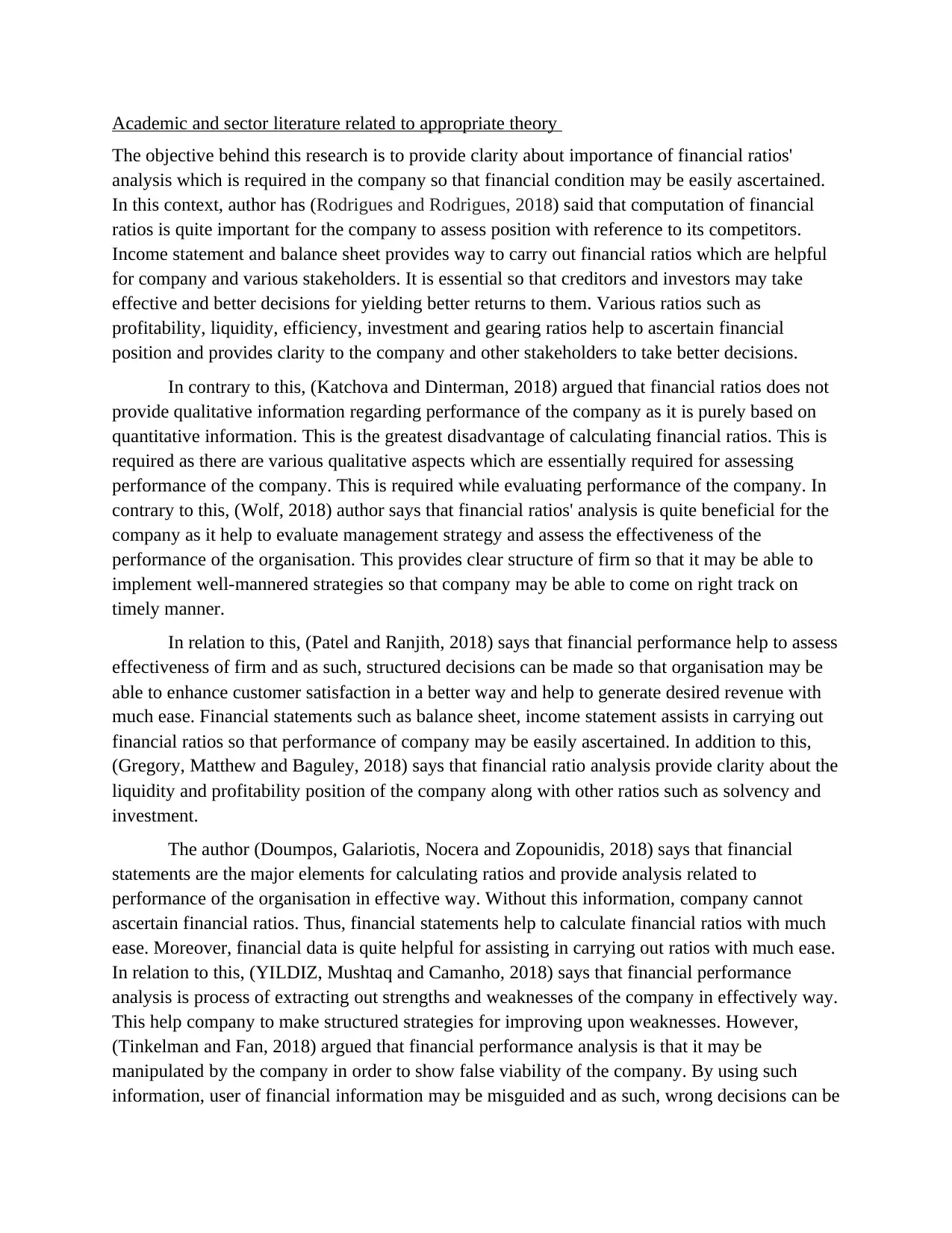
Academic and sector literature related to appropriate theory
The objective behind this research is to provide clarity about importance of financial ratios'
analysis which is required in the company so that financial condition may be easily ascertained.
In this context, author has (Rodrigues and Rodrigues, 2018) said that computation of financial
ratios is quite important for the company to assess position with reference to its competitors.
Income statement and balance sheet provides way to carry out financial ratios which are helpful
for company and various stakeholders. It is essential so that creditors and investors may take
effective and better decisions for yielding better returns to them. Various ratios such as
profitability, liquidity, efficiency, investment and gearing ratios help to ascertain financial
position and provides clarity to the company and other stakeholders to take better decisions.
In contrary to this, (Katchova and Dinterman, 2018) argued that financial ratios does not
provide qualitative information regarding performance of the company as it is purely based on
quantitative information. This is the greatest disadvantage of calculating financial ratios. This is
required as there are various qualitative aspects which are essentially required for assessing
performance of the company. This is required while evaluating performance of the company. In
contrary to this, (Wolf, 2018) author says that financial ratios' analysis is quite beneficial for the
company as it help to evaluate management strategy and assess the effectiveness of the
performance of the organisation. This provides clear structure of firm so that it may be able to
implement well-mannered strategies so that company may be able to come on right track on
timely manner.
In relation to this, (Patel and Ranjith, 2018) says that financial performance help to assess
effectiveness of firm and as such, structured decisions can be made so that organisation may be
able to enhance customer satisfaction in a better way and help to generate desired revenue with
much ease. Financial statements such as balance sheet, income statement assists in carrying out
financial ratios so that performance of company may be easily ascertained. In addition to this,
(Gregory, Matthew and Baguley, 2018) says that financial ratio analysis provide clarity about the
liquidity and profitability position of the company along with other ratios such as solvency and
investment.
The author (Doumpos, Galariotis, Nocera and Zopounidis, 2018) says that financial
statements are the major elements for calculating ratios and provide analysis related to
performance of the organisation in effective way. Without this information, company cannot
ascertain financial ratios. Thus, financial statements help to calculate financial ratios with much
ease. Moreover, financial data is quite helpful for assisting in carrying out ratios with much ease.
In relation to this, (YILDIZ, Mushtaq and Camanho, 2018) says that financial performance
analysis is process of extracting out strengths and weaknesses of the company in effectively way.
This help company to make structured strategies for improving upon weaknesses. However,
(Tinkelman and Fan, 2018) argued that financial performance analysis is that it may be
manipulated by the company in order to show false viability of the company. By using such
information, user of financial information may be misguided and as such, wrong decisions can be
The objective behind this research is to provide clarity about importance of financial ratios'
analysis which is required in the company so that financial condition may be easily ascertained.
In this context, author has (Rodrigues and Rodrigues, 2018) said that computation of financial
ratios is quite important for the company to assess position with reference to its competitors.
Income statement and balance sheet provides way to carry out financial ratios which are helpful
for company and various stakeholders. It is essential so that creditors and investors may take
effective and better decisions for yielding better returns to them. Various ratios such as
profitability, liquidity, efficiency, investment and gearing ratios help to ascertain financial
position and provides clarity to the company and other stakeholders to take better decisions.
In contrary to this, (Katchova and Dinterman, 2018) argued that financial ratios does not
provide qualitative information regarding performance of the company as it is purely based on
quantitative information. This is the greatest disadvantage of calculating financial ratios. This is
required as there are various qualitative aspects which are essentially required for assessing
performance of the company. This is required while evaluating performance of the company. In
contrary to this, (Wolf, 2018) author says that financial ratios' analysis is quite beneficial for the
company as it help to evaluate management strategy and assess the effectiveness of the
performance of the organisation. This provides clear structure of firm so that it may be able to
implement well-mannered strategies so that company may be able to come on right track on
timely manner.
In relation to this, (Patel and Ranjith, 2018) says that financial performance help to assess
effectiveness of firm and as such, structured decisions can be made so that organisation may be
able to enhance customer satisfaction in a better way and help to generate desired revenue with
much ease. Financial statements such as balance sheet, income statement assists in carrying out
financial ratios so that performance of company may be easily ascertained. In addition to this,
(Gregory, Matthew and Baguley, 2018) says that financial ratio analysis provide clarity about the
liquidity and profitability position of the company along with other ratios such as solvency and
investment.
The author (Doumpos, Galariotis, Nocera and Zopounidis, 2018) says that financial
statements are the major elements for calculating ratios and provide analysis related to
performance of the organisation in effective way. Without this information, company cannot
ascertain financial ratios. Thus, financial statements help to calculate financial ratios with much
ease. Moreover, financial data is quite helpful for assisting in carrying out ratios with much ease.
In relation to this, (YILDIZ, Mushtaq and Camanho, 2018) says that financial performance
analysis is process of extracting out strengths and weaknesses of the company in effectively way.
This help company to make structured strategies for improving upon weaknesses. However,
(Tinkelman and Fan, 2018) argued that financial performance analysis is that it may be
manipulated by the company in order to show false viability of the company. By using such
information, user of financial information may be misguided and as such, wrong decisions can be
Paraphrase This Document
Need a fresh take? Get an instant paraphrase of this document with our AI Paraphraser
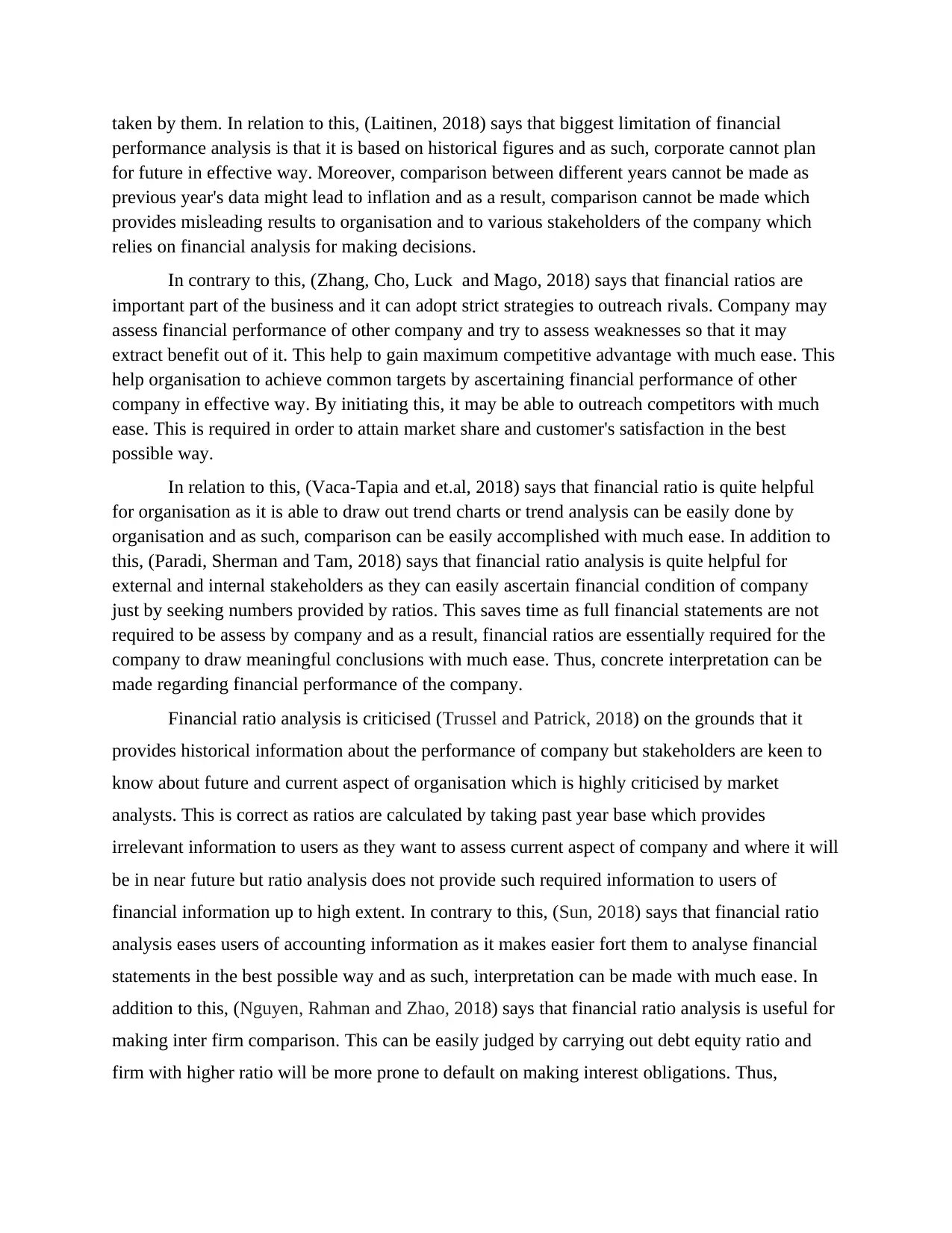
taken by them. In relation to this, (Laitinen, 2018) says that biggest limitation of financial
performance analysis is that it is based on historical figures and as such, corporate cannot plan
for future in effective way. Moreover, comparison between different years cannot be made as
previous year's data might lead to inflation and as a result, comparison cannot be made which
provides misleading results to organisation and to various stakeholders of the company which
relies on financial analysis for making decisions.
In contrary to this, (Zhang, Cho, Luck and Mago, 2018) says that financial ratios are
important part of the business and it can adopt strict strategies to outreach rivals. Company may
assess financial performance of other company and try to assess weaknesses so that it may
extract benefit out of it. This help to gain maximum competitive advantage with much ease. This
help organisation to achieve common targets by ascertaining financial performance of other
company in effective way. By initiating this, it may be able to outreach competitors with much
ease. This is required in order to attain market share and customer's satisfaction in the best
possible way.
In relation to this, (Vaca-Tapia and et.al, 2018) says that financial ratio is quite helpful
for organisation as it is able to draw out trend charts or trend analysis can be easily done by
organisation and as such, comparison can be easily accomplished with much ease. In addition to
this, (Paradi, Sherman and Tam, 2018) says that financial ratio analysis is quite helpful for
external and internal stakeholders as they can easily ascertain financial condition of company
just by seeking numbers provided by ratios. This saves time as full financial statements are not
required to be assess by company and as a result, financial ratios are essentially required for the
company to draw meaningful conclusions with much ease. Thus, concrete interpretation can be
made regarding financial performance of the company.
Financial ratio analysis is criticised (Trussel and Patrick, 2018) on the grounds that it
provides historical information about the performance of company but stakeholders are keen to
know about future and current aspect of organisation which is highly criticised by market
analysts. This is correct as ratios are calculated by taking past year base which provides
irrelevant information to users as they want to assess current aspect of company and where it will
be in near future but ratio analysis does not provide such required information to users of
financial information up to high extent. In contrary to this, (Sun, 2018) says that financial ratio
analysis eases users of accounting information as it makes easier fort them to analyse financial
statements in the best possible way and as such, interpretation can be made with much ease. In
addition to this, (Nguyen, Rahman and Zhao, 2018) says that financial ratio analysis is useful for
making inter firm comparison. This can be easily judged by carrying out debt equity ratio and
firm with higher ratio will be more prone to default on making interest obligations. Thus,
performance analysis is that it is based on historical figures and as such, corporate cannot plan
for future in effective way. Moreover, comparison between different years cannot be made as
previous year's data might lead to inflation and as a result, comparison cannot be made which
provides misleading results to organisation and to various stakeholders of the company which
relies on financial analysis for making decisions.
In contrary to this, (Zhang, Cho, Luck and Mago, 2018) says that financial ratios are
important part of the business and it can adopt strict strategies to outreach rivals. Company may
assess financial performance of other company and try to assess weaknesses so that it may
extract benefit out of it. This help to gain maximum competitive advantage with much ease. This
help organisation to achieve common targets by ascertaining financial performance of other
company in effective way. By initiating this, it may be able to outreach competitors with much
ease. This is required in order to attain market share and customer's satisfaction in the best
possible way.
In relation to this, (Vaca-Tapia and et.al, 2018) says that financial ratio is quite helpful
for organisation as it is able to draw out trend charts or trend analysis can be easily done by
organisation and as such, comparison can be easily accomplished with much ease. In addition to
this, (Paradi, Sherman and Tam, 2018) says that financial ratio analysis is quite helpful for
external and internal stakeholders as they can easily ascertain financial condition of company
just by seeking numbers provided by ratios. This saves time as full financial statements are not
required to be assess by company and as a result, financial ratios are essentially required for the
company to draw meaningful conclusions with much ease. Thus, concrete interpretation can be
made regarding financial performance of the company.
Financial ratio analysis is criticised (Trussel and Patrick, 2018) on the grounds that it
provides historical information about the performance of company but stakeholders are keen to
know about future and current aspect of organisation which is highly criticised by market
analysts. This is correct as ratios are calculated by taking past year base which provides
irrelevant information to users as they want to assess current aspect of company and where it will
be in near future but ratio analysis does not provide such required information to users of
financial information up to high extent. In contrary to this, (Sun, 2018) says that financial ratio
analysis eases users of accounting information as it makes easier fort them to analyse financial
statements in the best possible way and as such, interpretation can be made with much ease. In
addition to this, (Nguyen, Rahman and Zhao, 2018) says that financial ratio analysis is useful for
making inter firm comparison. This can be easily judged by carrying out debt equity ratio and
firm with higher ratio will be more prone to default on making interest obligations. Thus,

financial ratios are helpful for making inter firm comparison in effective way. Ratios provide
clarity about the financial health of the company.
The application of theory to practice
As discussed above, it is studied that ratio analysis served as a veritable means to
monitor, measure, evaluate and improve the performance of an undertaking. It is one of the most
significant way to interpret the quantitative results of the enterprise and used by financial
managers who are extremely interested in assessing company’s capital structure, financial status
and profitability performance and compare it with the prevailing industry standard to highly
improvements as well as deterioration. It is a systematic way to analyze both the internal as well
as external financial statements and assist managers in appraising business performance in future
(Kim and et.al., 2016). Analysis of current performance facilitates managerial team to judge the
relationship between two different amounts containing in its financial statement. Ratio presents
historical trends, compares current results and gives an indication to asses future possibility.
Thus, by this way, it works as a signpost for making better policies and plans that will enable
firms to grow in near future (Revell, 2016).
Ratio analysis of Thomas Cook, TUI Group and Carnival Plc
Profitability analysis
Gross profit ratio: Thomas Cook strives towards innovation to maximize its yield and
improve performance. Financial Year 2017 generate progressive results through a number of
steps that firm had attempted to strengthen their position in competitive marketplace. In FY
2017, Thomas Cook’s gross margin is 22.13% greater than both the competitors, TUI Group Plc
and Carnival Plc. This year, firm had attracted rising number of customers through launching
three promises comprising quality, service and reliability that had successfully contributed
towards maximizing its sales. In this year, firm added 112,000 additional images on website and
launched 1200 new room plans as well as 520 hotel and destination videos that enrich its website
crowd. Moreover, investment in website market on a large-scale tends to increase online booking
and increased total online sales by 3% covering 46% online booking. Particularly, web booking
rose by 21%, 27% and 7% in Germany, UK and Scandinavia (Thomas Cook’s annual report,
2017). In addition, firm reshaped its retail network through opening nine discovery stores while
clarity about the financial health of the company.
The application of theory to practice
As discussed above, it is studied that ratio analysis served as a veritable means to
monitor, measure, evaluate and improve the performance of an undertaking. It is one of the most
significant way to interpret the quantitative results of the enterprise and used by financial
managers who are extremely interested in assessing company’s capital structure, financial status
and profitability performance and compare it with the prevailing industry standard to highly
improvements as well as deterioration. It is a systematic way to analyze both the internal as well
as external financial statements and assist managers in appraising business performance in future
(Kim and et.al., 2016). Analysis of current performance facilitates managerial team to judge the
relationship between two different amounts containing in its financial statement. Ratio presents
historical trends, compares current results and gives an indication to asses future possibility.
Thus, by this way, it works as a signpost for making better policies and plans that will enable
firms to grow in near future (Revell, 2016).
Ratio analysis of Thomas Cook, TUI Group and Carnival Plc
Profitability analysis
Gross profit ratio: Thomas Cook strives towards innovation to maximize its yield and
improve performance. Financial Year 2017 generate progressive results through a number of
steps that firm had attempted to strengthen their position in competitive marketplace. In FY
2017, Thomas Cook’s gross margin is 22.13% greater than both the competitors, TUI Group Plc
and Carnival Plc. This year, firm had attracted rising number of customers through launching
three promises comprising quality, service and reliability that had successfully contributed
towards maximizing its sales. In this year, firm added 112,000 additional images on website and
launched 1200 new room plans as well as 520 hotel and destination videos that enrich its website
crowd. Moreover, investment in website market on a large-scale tends to increase online booking
and increased total online sales by 3% covering 46% online booking. Particularly, web booking
rose by 21%, 27% and 7% in Germany, UK and Scandinavia (Thomas Cook’s annual report,
2017). In addition, firm reshaped its retail network through opening nine discovery stores while
⊘ This is a preview!⊘
Do you want full access?
Subscribe today to unlock all pages.

Trusted by 1+ million students worldwide

number of stores fallen from 790 to 692. Besides this, mobile app strengthen its relationship with
customers and increased added service sales. Strategic alliance with Expedia, partnership with
Swiss hotel, LMEY investment had grown its own brand portfolio and drive wonderful growth.
With the improvement in quality, company became able to drive greater amount of
bookings. Moreover, ancillary services including seat reservation, meals on board, insurance, in-
resort transfer, extra luggage and excursion facilitate increased its sales by 10%. Furthermore,
expansion of long-haul business by increasing the number of seat to new destinations like San
Diego, San Francisco and New Orleans promote total sales. However, on the other side, although
volume related growth and high fuel prices increased its cost of sale, still, core focus of the
management to drive cost efficiency helped to boost profitability by responding adverse changes
in foreign exchange rate. Firm had faced competitive pricing pressure, which mitigated through
rerouting capacity from Spanish to Italy, Greece and Bulgaria contributes to optimize its yield. A
considerable growth in the revenue increased gross margin by GBP 56 million at 22.1%. Still,
from previous year (2016: 27.8%), it dropped down by 130 basis because of political uncertainty
in Mediterranean, terrorist attacks in Egypt, Turkish political turmoil. In order to respond it, firm
raise prices and passed on high cost to customers effected profit adversely (Robdavies, 2017). In
comparison to Thomas Cook, TUI Group Plc’s gross margin is just 10.79%. Macroeconomic
risk, more importantly brexit drive uncertainty over business aspect due to depreciated sterling
values which increase the cost of input. Moreover, safety and security concerns in Mediterranean
destinations depressed demand (TUI Group’s annual report, 2017). It’s likewise turnover
outperformed with 11.7% increase. Moreover, capacity growth, strong demand, high occupancy
for cruise ships help business to expand its fleet. On the other hand, Carnival Plc has gross profit
ratio of 40 % which is good as compared to other companies.
Net profit ratio: Thomas Cook’s net profit ratio seems too low to just 0.13% due to
increase in operating expenditures by 2%. In this year, its efficiency initiatives offset due to
increase in volume and inflation. Depreciation shows an increase by GBP 4 million because of
enhanced investment in IT and aircraft fleet. Group had struggled with the uncertain political and
economic environment such as weaker sterling value, inflation in hotel price and high air
capacity that make the sector highly competitive and put pressure on the company to control cost
and selling price as well (Taani and Banykhaled,2011). Unpredictable market changes and
customers and increased added service sales. Strategic alliance with Expedia, partnership with
Swiss hotel, LMEY investment had grown its own brand portfolio and drive wonderful growth.
With the improvement in quality, company became able to drive greater amount of
bookings. Moreover, ancillary services including seat reservation, meals on board, insurance, in-
resort transfer, extra luggage and excursion facilitate increased its sales by 10%. Furthermore,
expansion of long-haul business by increasing the number of seat to new destinations like San
Diego, San Francisco and New Orleans promote total sales. However, on the other side, although
volume related growth and high fuel prices increased its cost of sale, still, core focus of the
management to drive cost efficiency helped to boost profitability by responding adverse changes
in foreign exchange rate. Firm had faced competitive pricing pressure, which mitigated through
rerouting capacity from Spanish to Italy, Greece and Bulgaria contributes to optimize its yield. A
considerable growth in the revenue increased gross margin by GBP 56 million at 22.1%. Still,
from previous year (2016: 27.8%), it dropped down by 130 basis because of political uncertainty
in Mediterranean, terrorist attacks in Egypt, Turkish political turmoil. In order to respond it, firm
raise prices and passed on high cost to customers effected profit adversely (Robdavies, 2017). In
comparison to Thomas Cook, TUI Group Plc’s gross margin is just 10.79%. Macroeconomic
risk, more importantly brexit drive uncertainty over business aspect due to depreciated sterling
values which increase the cost of input. Moreover, safety and security concerns in Mediterranean
destinations depressed demand (TUI Group’s annual report, 2017). It’s likewise turnover
outperformed with 11.7% increase. Moreover, capacity growth, strong demand, high occupancy
for cruise ships help business to expand its fleet. On the other hand, Carnival Plc has gross profit
ratio of 40 % which is good as compared to other companies.
Net profit ratio: Thomas Cook’s net profit ratio seems too low to just 0.13% due to
increase in operating expenditures by 2%. In this year, its efficiency initiatives offset due to
increase in volume and inflation. Depreciation shows an increase by GBP 4 million because of
enhanced investment in IT and aircraft fleet. Group had struggled with the uncertain political and
economic environment such as weaker sterling value, inflation in hotel price and high air
capacity that make the sector highly competitive and put pressure on the company to control cost
and selling price as well (Taani and Banykhaled,2011). Unpredictable market changes and
Paraphrase This Document
Need a fresh take? Get an instant paraphrase of this document with our AI Paraphraser
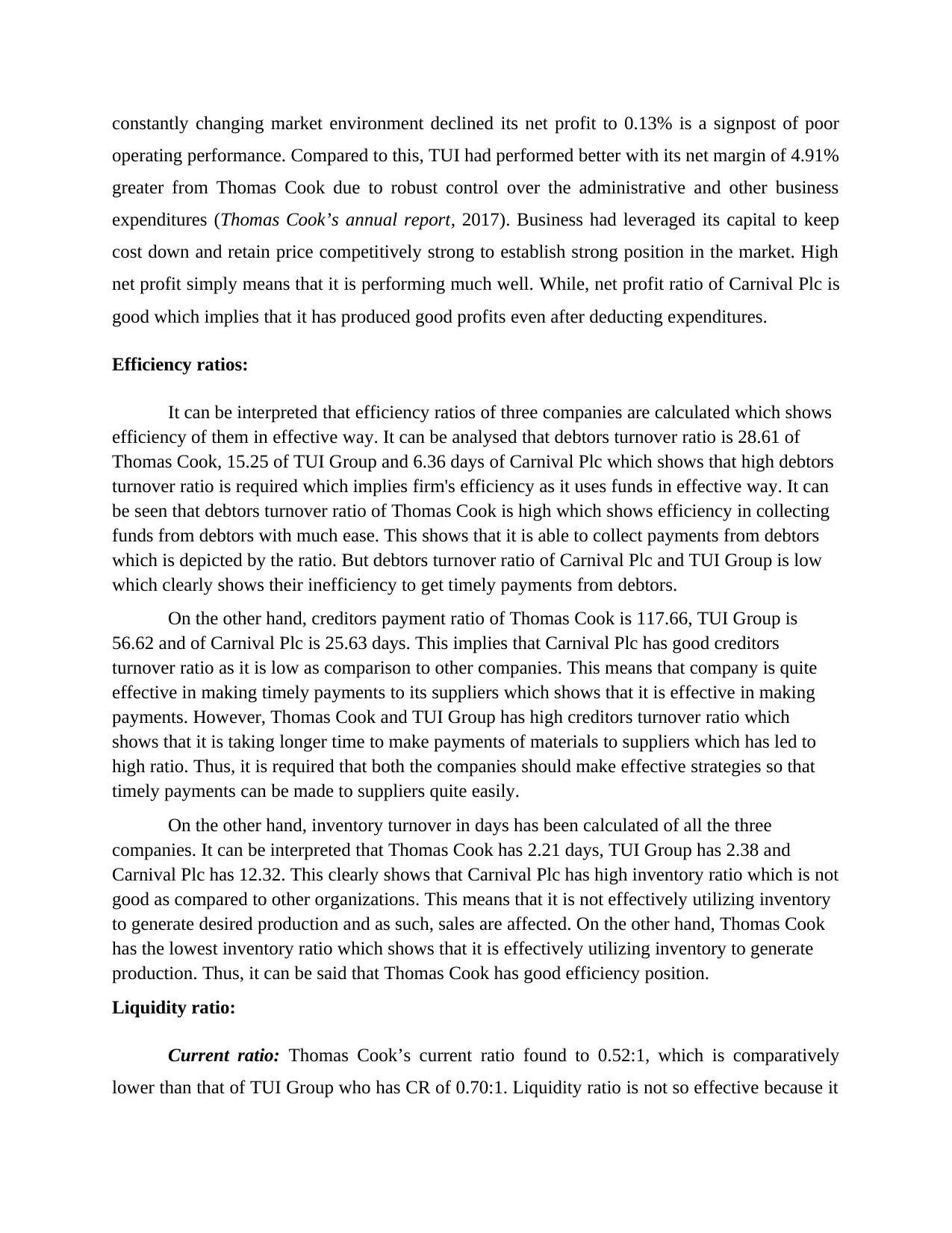
constantly changing market environment declined its net profit to 0.13% is a signpost of poor
operating performance. Compared to this, TUI had performed better with its net margin of 4.91%
greater from Thomas Cook due to robust control over the administrative and other business
expenditures (Thomas Cook’s annual report, 2017). Business had leveraged its capital to keep
cost down and retain price competitively strong to establish strong position in the market. High
net profit simply means that it is performing much well. While, net profit ratio of Carnival Plc is
good which implies that it has produced good profits even after deducting expenditures.
Efficiency ratios:
It can be interpreted that efficiency ratios of three companies are calculated which shows
efficiency of them in effective way. It can be analysed that debtors turnover ratio is 28.61 of
Thomas Cook, 15.25 of TUI Group and 6.36 days of Carnival Plc which shows that high debtors
turnover ratio is required which implies firm's efficiency as it uses funds in effective way. It can
be seen that debtors turnover ratio of Thomas Cook is high which shows efficiency in collecting
funds from debtors with much ease. This shows that it is able to collect payments from debtors
which is depicted by the ratio. But debtors turnover ratio of Carnival Plc and TUI Group is low
which clearly shows their inefficiency to get timely payments from debtors.
On the other hand, creditors payment ratio of Thomas Cook is 117.66, TUI Group is
56.62 and of Carnival Plc is 25.63 days. This implies that Carnival Plc has good creditors
turnover ratio as it is low as comparison to other companies. This means that company is quite
effective in making timely payments to its suppliers which shows that it is effective in making
payments. However, Thomas Cook and TUI Group has high creditors turnover ratio which
shows that it is taking longer time to make payments of materials to suppliers which has led to
high ratio. Thus, it is required that both the companies should make effective strategies so that
timely payments can be made to suppliers quite easily.
On the other hand, inventory turnover in days has been calculated of all the three
companies. It can be interpreted that Thomas Cook has 2.21 days, TUI Group has 2.38 and
Carnival Plc has 12.32. This clearly shows that Carnival Plc has high inventory ratio which is not
good as compared to other organizations. This means that it is not effectively utilizing inventory
to generate desired production and as such, sales are affected. On the other hand, Thomas Cook
has the lowest inventory ratio which shows that it is effectively utilizing inventory to generate
production. Thus, it can be said that Thomas Cook has good efficiency position.
Liquidity ratio:
Current ratio: Thomas Cook’s current ratio found to 0.52:1, which is comparatively
lower than that of TUI Group who has CR of 0.70:1. Liquidity ratio is not so effective because it
operating performance. Compared to this, TUI had performed better with its net margin of 4.91%
greater from Thomas Cook due to robust control over the administrative and other business
expenditures (Thomas Cook’s annual report, 2017). Business had leveraged its capital to keep
cost down and retain price competitively strong to establish strong position in the market. High
net profit simply means that it is performing much well. While, net profit ratio of Carnival Plc is
good which implies that it has produced good profits even after deducting expenditures.
Efficiency ratios:
It can be interpreted that efficiency ratios of three companies are calculated which shows
efficiency of them in effective way. It can be analysed that debtors turnover ratio is 28.61 of
Thomas Cook, 15.25 of TUI Group and 6.36 days of Carnival Plc which shows that high debtors
turnover ratio is required which implies firm's efficiency as it uses funds in effective way. It can
be seen that debtors turnover ratio of Thomas Cook is high which shows efficiency in collecting
funds from debtors with much ease. This shows that it is able to collect payments from debtors
which is depicted by the ratio. But debtors turnover ratio of Carnival Plc and TUI Group is low
which clearly shows their inefficiency to get timely payments from debtors.
On the other hand, creditors payment ratio of Thomas Cook is 117.66, TUI Group is
56.62 and of Carnival Plc is 25.63 days. This implies that Carnival Plc has good creditors
turnover ratio as it is low as comparison to other companies. This means that company is quite
effective in making timely payments to its suppliers which shows that it is effective in making
payments. However, Thomas Cook and TUI Group has high creditors turnover ratio which
shows that it is taking longer time to make payments of materials to suppliers which has led to
high ratio. Thus, it is required that both the companies should make effective strategies so that
timely payments can be made to suppliers quite easily.
On the other hand, inventory turnover in days has been calculated of all the three
companies. It can be interpreted that Thomas Cook has 2.21 days, TUI Group has 2.38 and
Carnival Plc has 12.32. This clearly shows that Carnival Plc has high inventory ratio which is not
good as compared to other organizations. This means that it is not effectively utilizing inventory
to generate desired production and as such, sales are affected. On the other hand, Thomas Cook
has the lowest inventory ratio which shows that it is effectively utilizing inventory to generate
production. Thus, it can be said that Thomas Cook has good efficiency position.
Liquidity ratio:
Current ratio: Thomas Cook’s current ratio found to 0.52:1, which is comparatively
lower than that of TUI Group who has CR of 0.70:1. Liquidity ratio is not so effective because it
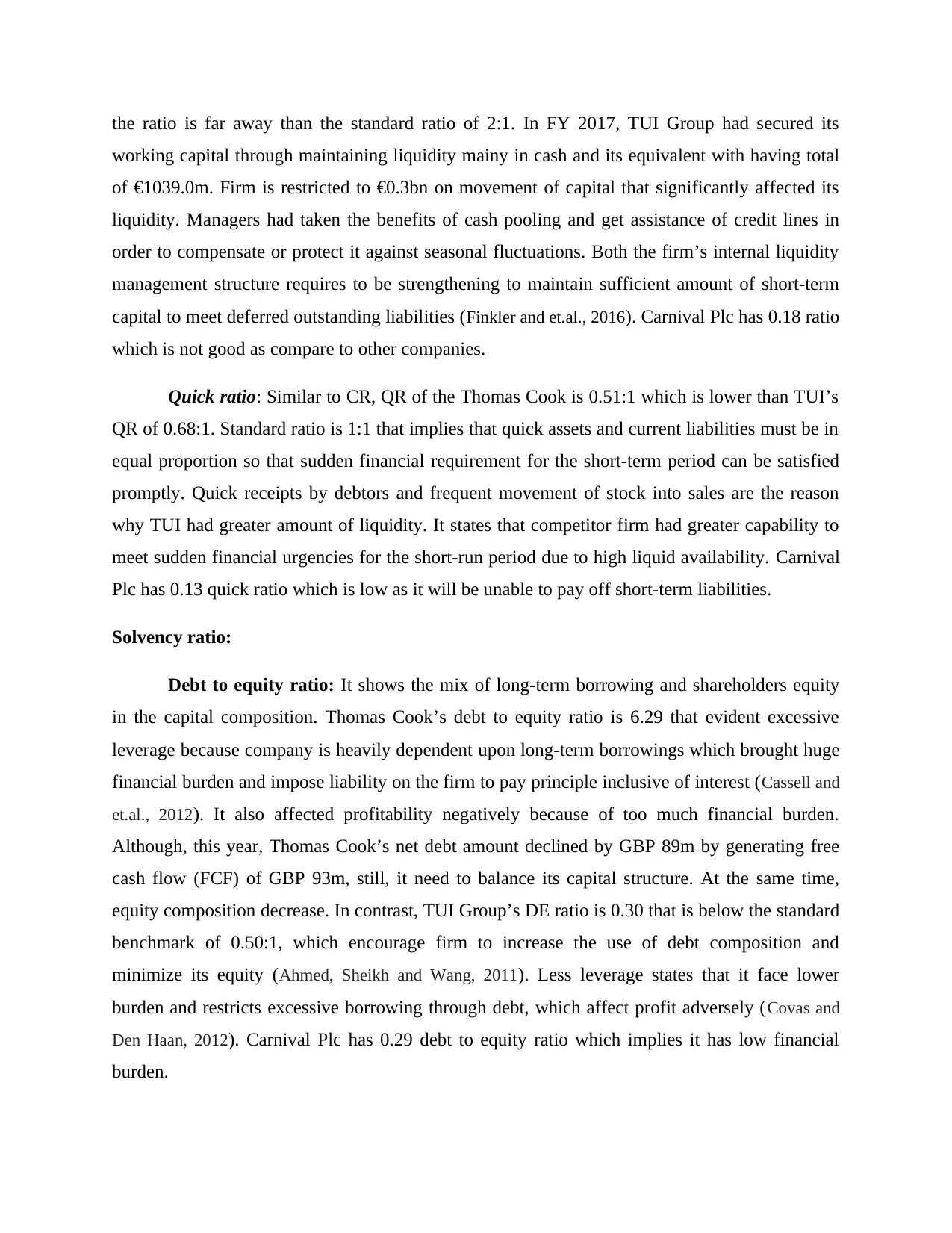
the ratio is far away than the standard ratio of 2:1. In FY 2017, TUI Group had secured its
working capital through maintaining liquidity mainy in cash and its equivalent with having total
of €1039.0m. Firm is restricted to €0.3bn on movement of capital that significantly affected its
liquidity. Managers had taken the benefits of cash pooling and get assistance of credit lines in
order to compensate or protect it against seasonal fluctuations. Both the firm’s internal liquidity
management structure requires to be strengthening to maintain sufficient amount of short-term
capital to meet deferred outstanding liabilities (Finkler and et.al., 2016). Carnival Plc has 0.18 ratio
which is not good as compare to other companies.
Quick ratio: Similar to CR, QR of the Thomas Cook is 0.51:1 which is lower than TUI’s
QR of 0.68:1. Standard ratio is 1:1 that implies that quick assets and current liabilities must be in
equal proportion so that sudden financial requirement for the short-term period can be satisfied
promptly. Quick receipts by debtors and frequent movement of stock into sales are the reason
why TUI had greater amount of liquidity. It states that competitor firm had greater capability to
meet sudden financial urgencies for the short-run period due to high liquid availability. Carnival
Plc has 0.13 quick ratio which is low as it will be unable to pay off short-term liabilities.
Solvency ratio:
Debt to equity ratio: It shows the mix of long-term borrowing and shareholders equity
in the capital composition. Thomas Cook’s debt to equity ratio is 6.29 that evident excessive
leverage because company is heavily dependent upon long-term borrowings which brought huge
financial burden and impose liability on the firm to pay principle inclusive of interest (Cassell and
et.al., 2012). It also affected profitability negatively because of too much financial burden.
Although, this year, Thomas Cook’s net debt amount declined by GBP 89m by generating free
cash flow (FCF) of GBP 93m, still, it need to balance its capital structure. At the same time,
equity composition decrease. In contrast, TUI Group’s DE ratio is 0.30 that is below the standard
benchmark of 0.50:1, which encourage firm to increase the use of debt composition and
minimize its equity (Ahmed, Sheikh and Wang, 2011). Less leverage states that it face lower
burden and restricts excessive borrowing through debt, which affect profit adversely (Covas and
Den Haan, 2012). Carnival Plc has 0.29 debt to equity ratio which implies it has low financial
burden.
working capital through maintaining liquidity mainy in cash and its equivalent with having total
of €1039.0m. Firm is restricted to €0.3bn on movement of capital that significantly affected its
liquidity. Managers had taken the benefits of cash pooling and get assistance of credit lines in
order to compensate or protect it against seasonal fluctuations. Both the firm’s internal liquidity
management structure requires to be strengthening to maintain sufficient amount of short-term
capital to meet deferred outstanding liabilities (Finkler and et.al., 2016). Carnival Plc has 0.18 ratio
which is not good as compare to other companies.
Quick ratio: Similar to CR, QR of the Thomas Cook is 0.51:1 which is lower than TUI’s
QR of 0.68:1. Standard ratio is 1:1 that implies that quick assets and current liabilities must be in
equal proportion so that sudden financial requirement for the short-term period can be satisfied
promptly. Quick receipts by debtors and frequent movement of stock into sales are the reason
why TUI had greater amount of liquidity. It states that competitor firm had greater capability to
meet sudden financial urgencies for the short-run period due to high liquid availability. Carnival
Plc has 0.13 quick ratio which is low as it will be unable to pay off short-term liabilities.
Solvency ratio:
Debt to equity ratio: It shows the mix of long-term borrowing and shareholders equity
in the capital composition. Thomas Cook’s debt to equity ratio is 6.29 that evident excessive
leverage because company is heavily dependent upon long-term borrowings which brought huge
financial burden and impose liability on the firm to pay principle inclusive of interest (Cassell and
et.al., 2012). It also affected profitability negatively because of too much financial burden.
Although, this year, Thomas Cook’s net debt amount declined by GBP 89m by generating free
cash flow (FCF) of GBP 93m, still, it need to balance its capital structure. At the same time,
equity composition decrease. In contrast, TUI Group’s DE ratio is 0.30 that is below the standard
benchmark of 0.50:1, which encourage firm to increase the use of debt composition and
minimize its equity (Ahmed, Sheikh and Wang, 2011). Less leverage states that it face lower
burden and restricts excessive borrowing through debt, which affect profit adversely (Covas and
Den Haan, 2012). Carnival Plc has 0.29 debt to equity ratio which implies it has low financial
burden.
⊘ This is a preview!⊘
Do you want full access?
Subscribe today to unlock all pages.

Trusted by 1+ million students worldwide
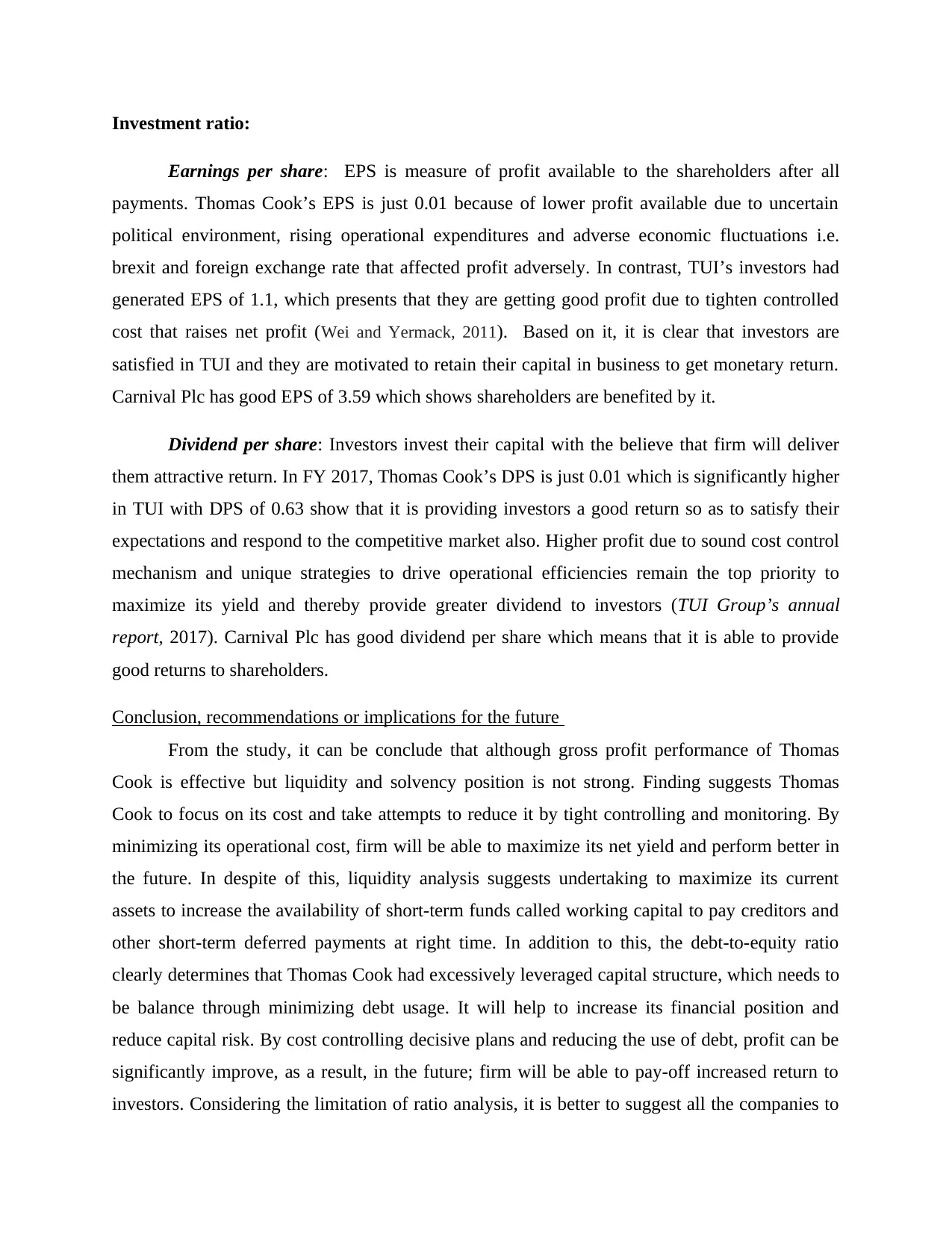
Investment ratio:
Earnings per share: EPS is measure of profit available to the shareholders after all
payments. Thomas Cook’s EPS is just 0.01 because of lower profit available due to uncertain
political environment, rising operational expenditures and adverse economic fluctuations i.e.
brexit and foreign exchange rate that affected profit adversely. In contrast, TUI’s investors had
generated EPS of 1.1, which presents that they are getting good profit due to tighten controlled
cost that raises net profit (Wei and Yermack, 2011). Based on it, it is clear that investors are
satisfied in TUI and they are motivated to retain their capital in business to get monetary return.
Carnival Plc has good EPS of 3.59 which shows shareholders are benefited by it.
Dividend per share: Investors invest their capital with the believe that firm will deliver
them attractive return. In FY 2017, Thomas Cook’s DPS is just 0.01 which is significantly higher
in TUI with DPS of 0.63 show that it is providing investors a good return so as to satisfy their
expectations and respond to the competitive market also. Higher profit due to sound cost control
mechanism and unique strategies to drive operational efficiencies remain the top priority to
maximize its yield and thereby provide greater dividend to investors (TUI Group’s annual
report, 2017). Carnival Plc has good dividend per share which means that it is able to provide
good returns to shareholders.
Conclusion, recommendations or implications for the future
From the study, it can be conclude that although gross profit performance of Thomas
Cook is effective but liquidity and solvency position is not strong. Finding suggests Thomas
Cook to focus on its cost and take attempts to reduce it by tight controlling and monitoring. By
minimizing its operational cost, firm will be able to maximize its net yield and perform better in
the future. In despite of this, liquidity analysis suggests undertaking to maximize its current
assets to increase the availability of short-term funds called working capital to pay creditors and
other short-term deferred payments at right time. In addition to this, the debt-to-equity ratio
clearly determines that Thomas Cook had excessively leveraged capital structure, which needs to
be balance through minimizing debt usage. It will help to increase its financial position and
reduce capital risk. By cost controlling decisive plans and reducing the use of debt, profit can be
significantly improve, as a result, in the future; firm will be able to pay-off increased return to
investors. Considering the limitation of ratio analysis, it is better to suggest all the companies to
Earnings per share: EPS is measure of profit available to the shareholders after all
payments. Thomas Cook’s EPS is just 0.01 because of lower profit available due to uncertain
political environment, rising operational expenditures and adverse economic fluctuations i.e.
brexit and foreign exchange rate that affected profit adversely. In contrast, TUI’s investors had
generated EPS of 1.1, which presents that they are getting good profit due to tighten controlled
cost that raises net profit (Wei and Yermack, 2011). Based on it, it is clear that investors are
satisfied in TUI and they are motivated to retain their capital in business to get monetary return.
Carnival Plc has good EPS of 3.59 which shows shareholders are benefited by it.
Dividend per share: Investors invest their capital with the believe that firm will deliver
them attractive return. In FY 2017, Thomas Cook’s DPS is just 0.01 which is significantly higher
in TUI with DPS of 0.63 show that it is providing investors a good return so as to satisfy their
expectations and respond to the competitive market also. Higher profit due to sound cost control
mechanism and unique strategies to drive operational efficiencies remain the top priority to
maximize its yield and thereby provide greater dividend to investors (TUI Group’s annual
report, 2017). Carnival Plc has good dividend per share which means that it is able to provide
good returns to shareholders.
Conclusion, recommendations or implications for the future
From the study, it can be conclude that although gross profit performance of Thomas
Cook is effective but liquidity and solvency position is not strong. Finding suggests Thomas
Cook to focus on its cost and take attempts to reduce it by tight controlling and monitoring. By
minimizing its operational cost, firm will be able to maximize its net yield and perform better in
the future. In despite of this, liquidity analysis suggests undertaking to maximize its current
assets to increase the availability of short-term funds called working capital to pay creditors and
other short-term deferred payments at right time. In addition to this, the debt-to-equity ratio
clearly determines that Thomas Cook had excessively leveraged capital structure, which needs to
be balance through minimizing debt usage. It will help to increase its financial position and
reduce capital risk. By cost controlling decisive plans and reducing the use of debt, profit can be
significantly improve, as a result, in the future; firm will be able to pay-off increased return to
investors. Considering the limitation of ratio analysis, it is better to suggest all the companies to
Paraphrase This Document
Need a fresh take? Get an instant paraphrase of this document with our AI Paraphraser

just not dependent on the ratio analysis for quantitative assessment and conduct qualitative
assessment to consider the impact of external volatility on their performance.
assessment to consider the impact of external volatility on their performance.
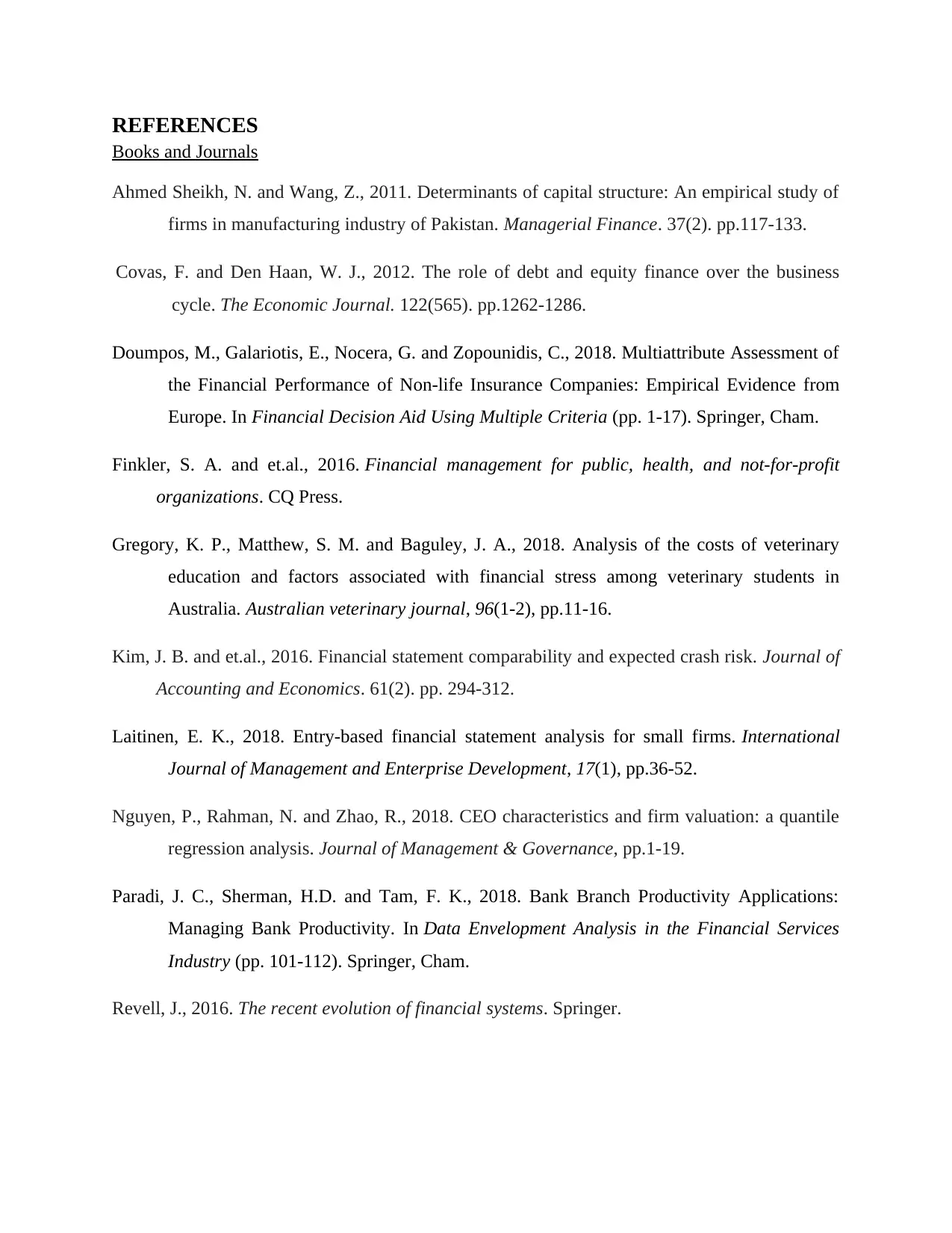
REFERENCES
Books and Journals
Ahmed Sheikh, N. and Wang, Z., 2011. Determinants of capital structure: An empirical study of
firms in manufacturing industry of Pakistan. Managerial Finance. 37(2). pp.117-133.
Covas, F. and Den Haan, W. J., 2012. The role of debt and equity finance over the business
cycle. The Economic Journal. 122(565). pp.1262-1286.
Doumpos, M., Galariotis, E., Nocera, G. and Zopounidis, C., 2018. Multiattribute Assessment of
the Financial Performance of Non-life Insurance Companies: Empirical Evidence from
Europe. In Financial Decision Aid Using Multiple Criteria (pp. 1-17). Springer, Cham.
Finkler, S. A. and et.al., 2016. Financial management for public, health, and not-for-profit
organizations. CQ Press.
Gregory, K. P., Matthew, S. M. and Baguley, J. A., 2018. Analysis of the costs of veterinary
education and factors associated with financial stress among veterinary students in
Australia. Australian veterinary journal, 96(1-2), pp.11-16.
Kim, J. B. and et.al., 2016. Financial statement comparability and expected crash risk. Journal of
Accounting and Economics. 61(2). pp. 294-312.
Laitinen, E. K., 2018. Entry-based financial statement analysis for small firms. International
Journal of Management and Enterprise Development, 17(1), pp.36-52.
Nguyen, P., Rahman, N. and Zhao, R., 2018. CEO characteristics and firm valuation: a quantile
regression analysis. Journal of Management & Governance, pp.1-19.
Paradi, J. C., Sherman, H.D. and Tam, F. K., 2018. Bank Branch Productivity Applications:
Managing Bank Productivity. In Data Envelopment Analysis in the Financial Services
Industry (pp. 101-112). Springer, Cham.
Revell, J., 2016. The recent evolution of financial systems. Springer.
Books and Journals
Ahmed Sheikh, N. and Wang, Z., 2011. Determinants of capital structure: An empirical study of
firms in manufacturing industry of Pakistan. Managerial Finance. 37(2). pp.117-133.
Covas, F. and Den Haan, W. J., 2012. The role of debt and equity finance over the business
cycle. The Economic Journal. 122(565). pp.1262-1286.
Doumpos, M., Galariotis, E., Nocera, G. and Zopounidis, C., 2018. Multiattribute Assessment of
the Financial Performance of Non-life Insurance Companies: Empirical Evidence from
Europe. In Financial Decision Aid Using Multiple Criteria (pp. 1-17). Springer, Cham.
Finkler, S. A. and et.al., 2016. Financial management for public, health, and not-for-profit
organizations. CQ Press.
Gregory, K. P., Matthew, S. M. and Baguley, J. A., 2018. Analysis of the costs of veterinary
education and factors associated with financial stress among veterinary students in
Australia. Australian veterinary journal, 96(1-2), pp.11-16.
Kim, J. B. and et.al., 2016. Financial statement comparability and expected crash risk. Journal of
Accounting and Economics. 61(2). pp. 294-312.
Laitinen, E. K., 2018. Entry-based financial statement analysis for small firms. International
Journal of Management and Enterprise Development, 17(1), pp.36-52.
Nguyen, P., Rahman, N. and Zhao, R., 2018. CEO characteristics and firm valuation: a quantile
regression analysis. Journal of Management & Governance, pp.1-19.
Paradi, J. C., Sherman, H.D. and Tam, F. K., 2018. Bank Branch Productivity Applications:
Managing Bank Productivity. In Data Envelopment Analysis in the Financial Services
Industry (pp. 101-112). Springer, Cham.
Revell, J., 2016. The recent evolution of financial systems. Springer.
⊘ This is a preview!⊘
Do you want full access?
Subscribe today to unlock all pages.

Trusted by 1+ million students worldwide
1 out of 15
Related Documents
Your All-in-One AI-Powered Toolkit for Academic Success.
+13062052269
info@desklib.com
Available 24*7 on WhatsApp / Email
![[object Object]](/_next/static/media/star-bottom.7253800d.svg)
Unlock your academic potential
Copyright © 2020–2025 A2Z Services. All Rights Reserved. Developed and managed by ZUCOL.





